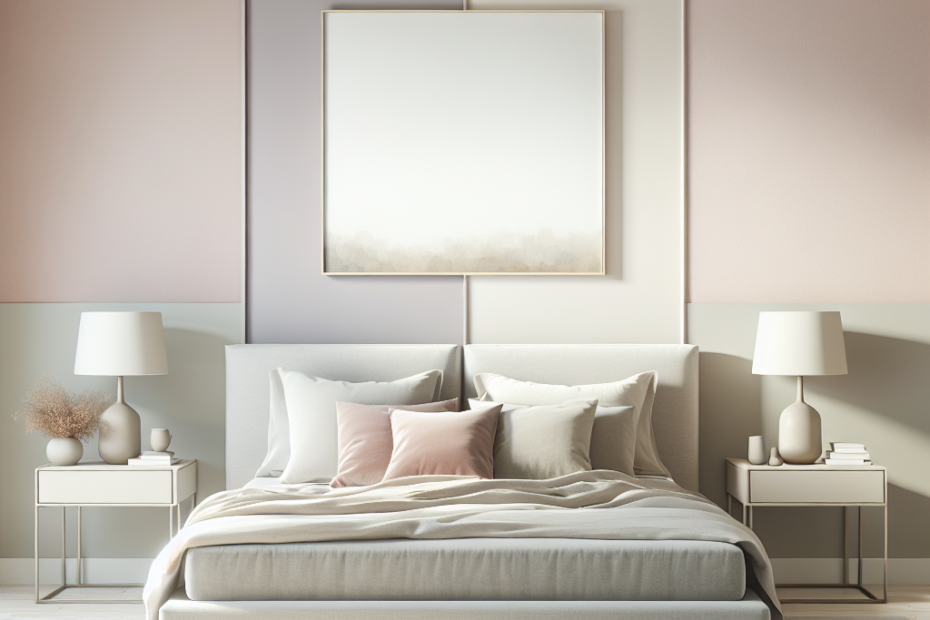How to Create a Calm and Relaxing Bedroom with Soft Colors
A relaxing bedroom is vital for mental and physical well-being. Bedrooms serve as sanctuaries where people unwind and recharge. Incorporating soft colors into a bedroom’s design can significantly improve comfort and tranquility. According to a survey by the National Sleep Foundation, 73% of individuals believe that a peaceful bedroom environment is key to achieving quality sleep. This blog post will guide readers on how to create a calm and relaxing bedroom using soft colors.
Choosing the Right Colors
Colors play a pivotal role in impacting mood and relaxation. Soft colors are known for their calming effect. Common relaxing colors include shades of blue, green, lavender, and beige. These colors invoke feelings of peace and serenity, which are essential for a good night’s sleep.
Blue
Blue is a popular choice for bedrooms because it evokes a sense of calm and stability. Light blue can create an airy feel, while deeper blues provide a cozy and secure atmosphere.
Green
Green represents nature and tranquility. It promotes relaxation and calmness. Light green tones are particularly soothing, making them ideal for bedroom spaces.
Lavender
Lavender is known for its calming properties. It strikes a balance between being soothing and uplifting, making it perfect for a relaxing bedroom ambiance.
Beige
Beige and other neutral tones can make the bedroom feel warm and inviting. These colors create a clean and clutter-free look, which contributes to relaxation.
Wall Paint and Wallpaper
Wall paint and wallpaper are the canvases for creating a serene bedroom. Choosing the right type is crucial. Soft, muted colors are recommended. Here are some pointers:
- Paint: Opt for matte or eggshell finishes which are less reflective and more calming than glossy finishes.
- Wallpaper: Soft-colored wallpapers with subtle patterns can add texture and interest without overwhelming the senses.
Furniture
Furniture should complement the soft color palette. This helps to create a cohesive and serene environment. Here are some suggestions:
- Wood Tones: Lighter wood tones, such as oak or pine, blend seamlessly with soft colors.
- Upholstery: Choose soft fabrics in neutral colors to maintain a calm atmosphere.
- Minimalism: Avoid overcrowding the room with furniture. A minimalist approach can enhance the feeling of relaxation.
Bedding and Accessories
Bedding and accessories are essential elements for creating a relaxing bedroom. They provide comfort and can enhance the room’s color scheme. Here are some tips:
- Bedding: Choose bedding in soft colors and high-quality, breathable fabrics like cotton or linen.
- Pillows and Throws: Add plush pillows and throws in complementary colors to create a cozy and inviting bed.
- Rugs: Soft, plush rugs can add warmth and comfort underfoot.
- Art and Decor: Choose artwork and decor in soothing hues that align with the room’s color palette.
Lighting
Proper lighting can enhance the relaxing atmosphere in the bedroom. Soft and adjustable lighting options are recommended. Here’s how to implement them:
- Natural Light: Ensure that windows are unobstructed to allow for ample natural light during the day.
- Artificial Light: Use dimmable lights and lamps with soft bulbs to create a gentle ambiance in the evening.
- Layering: Combine overhead lights, bedside lamps, and task lighting to provide flexibility and control over the room’s brightness.
| Color | Mood | Recommendation |
|---|---|---|
| Blue | Calm | For walls and accents |
| Green | Tranquil | For furniture and decor |
| Lavender | Soothing | For bedding and accessories |
| Beige | Warm and neutral | For walls and furniture |
Key Takeaways
- Choose soft colors like blue, green, lavender, and beige for a relaxing bedroom.
- Select wall paints and wallpapers in muted tones with matte finishes.
- Opt for light-colored, minimalist furniture.
- Use high-quality, soft bedding and accessories to enhance comfort.
- Implement adjustable and layered lighting to create a soothing ambiance.
FAQ
1. What are the best colors for a relaxing bedroom?
The best colors for a relaxing bedroom are soft hues such as blue, green, lavender, and beige.
2. How can I make my bedroom more relaxing?
To make your bedroom more relaxing, use soft colors, choose light and minimalistic furniture, incorporate high-quality bedding, and utilize adjustable lighting.
3. Why is color selection important for a relaxing bedroom?
Color selection is crucial because certain colors can influence mood and relaxation. Soft colors are known to create a calming and serene atmosphere.
4. What type of lighting is best for a relaxing bedroom?
Soft, adjustable lighting is best for a relaxing bedroom. Dimmable lights, bedside lamps, and layered lighting provide control over brightness.
5. Can furniture affect the relaxation of a bedroom?
Yes, furniture can affect the relaxation of a bedroom. Choosing light-colored, minimalist furniture helps to create a serene environment without causing clutter or discomfort.
